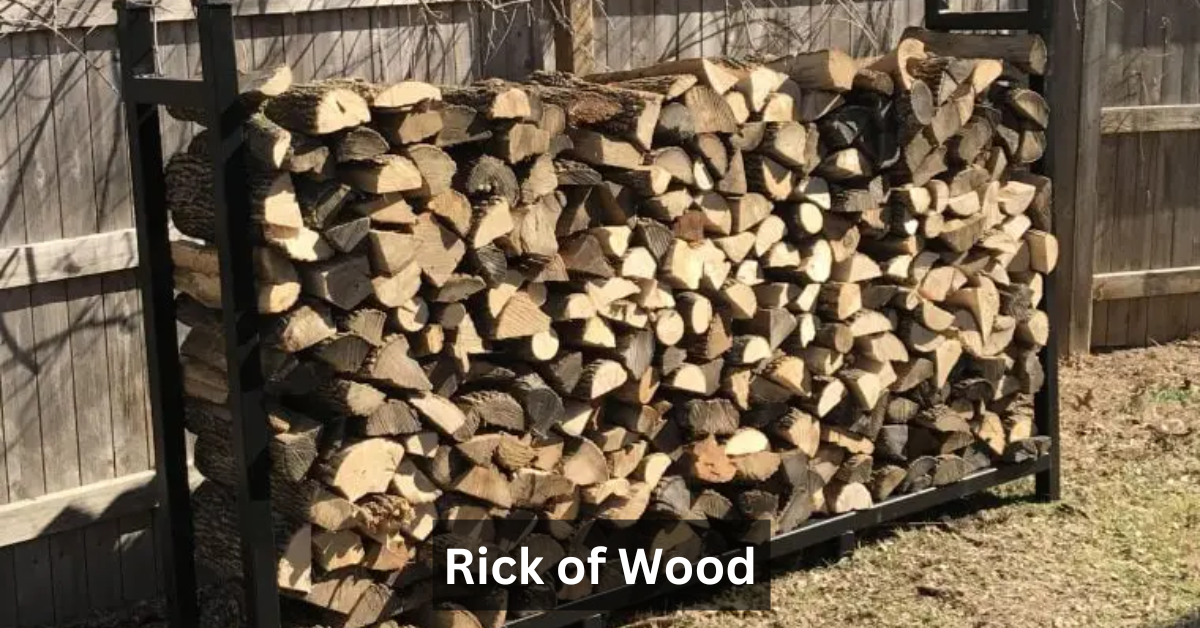A rick of wood is typically 4 feet tall, 8 feet long, and the depth depends on the log length, which is usually 12 to 24 inches.” Understanding this measurement and how it compares to other firewood measurements, like a cord or face cord, can save you time, money, and confusion. Whether you’re buying firewood to heat your home, fuel your wood-burning stove, or prepare for outdoor gatherings, this guide will provide the knowledge you need to make informed decisions.
What Is a Rick of Wood?
A rick of wood is a commonly used term for describing a stack of firewood. It is a specific measurement that is both practical and flexible, especially for buyers who do not need the bulk quantity of a full cord. Typically, a rick is a pile of wood that is 4 feet tall and 8 feet long, matching the height and length of a full cord. However, the depth of the stack—the length of the logs—varies, which means the overall volume of a rick is less than that of a cord. Common log lengths for a rick range between 12 and 24 inches, with 16 inches being the most popular. For example, a rick of 16-inch logs contains approximately one-third of the volume of a full cord.
The term “rick” may vary in definition depending on the region or firewood supplier, but it is universally understood to represent a stack of firewood organized neatly for easy transport and use. Unlike a cord, which is a strict standard measurement totaling 128 cubic feet (4 x 4 x 8 feet), a rick’s volume fluctuates with the depth of the logs. This flexibility makes it an excellent choice for those who need smaller amounts of wood without committing to a full cord.
Understanding the Difference: Rick vs. Cord of Wood
The difference between a rick and a cord of wood lies primarily in their depth and volume. A cord is a standardized unit of firewood measurement, always measuring 128 cubic feet, regardless of the log length. In comparison, a rick matches the cord in height (4 feet) and length (8 feet) but does not have a fixed depth. For instance, a rick with 12-inch logs will contain less wood than a rick with 24-inch logs, which can lead to variations in the overall amount of usable wood.
Because a cord provides a precise and predictable volume, it is the preferred measurement for large-scale firewood purchases. However, a rick is more practical for smaller needs, especially if you’re purchasing wood for seasonal heating or outdoor activities. To avoid misunderstandings when buying a rick, always confirm the log length with your supplier. Knowing how much wood you’re getting is crucial to ensure you’re paying a fair price.
Rick vs. Face Cord: Are They the Same?
A face cord is another term often associated with a rick, and the two are frequently used interchangeably. Both refer to a stack of firewood measuring 4 feet tall and 8 feet long. However, the difference lies in the implied depth or log length. A face cord, like a rick, does not have a fixed depth, so the volume of wood depends on the length of the logs. For example, a face cord with 16-inch logs contains about one-third the volume of a full cord, while a face cord with 24-inch logs contains closer to half.
This overlap in terminology can cause confusion, particularly for first-time buyers. To clarify, think of a face cord as a visual measurement that references the visible face of the stacked wood. The actual volume, like a rick, depends on the depth of the logs. Asking your supplier for the log length ensures you know exactly how much firewood you’re receiving.
Understanding Firewood Measurements
Firewood measurements play a vital role in determining the quantity of wood you need and the price you’ll pay. Common measurements include the cord, face cord, and rick. While a cord is a fixed standard, other measurements like the rick vary based on log length. For example, if a rick contains logs that are 16 inches long, the stack will have approximately 42.66 cubic feet of wood, which is one-third of a full cord.
The depth of the logs not only impacts the overall volume but also influences the efficiency and burn time of the wood. Shorter logs, such as 12 inches, tend to burn faster and are easier to handle, making them ideal for smaller stoves or outdoor fire pits. Longer logs, such as 24 inches, are better suited for larger fireplaces and wood-burning stoves, providing a slower, more sustained burn. By understanding these differences, you can choose the right firewood measurement to meet your specific needs.
Factors That Affect a Rick of Wood
Several factors influence the quality and usability of a rick of wood, including the type of wood, log length, and how the wood is stacked.
Wood Type: Hardwoods vs. Softwoods
The type of wood used in a rick can significantly impact its heating value, burn efficiency, and overall cost. Hardwoods, such as oak, maple, and hickory, are dense and produce more heat per log. They burn longer and are ideal for heating homes during cold months. Softwoods, such as pine and spruce, are lighter and burn faster, making them better suited for kindling or short-term fires. Choosing the right wood type depends on your intended use and budget.
Log Length and Stacking Method
The length of the logs in a rick determines its depth and overall volume. Logs that are 12 to 16 inches long are easier to stack and store, while longer logs, such as 24 inches, require more space but offer more burn time. The stacking method also plays a role in the volume of wood. A tightly stacked rick has minimal gaps between logs, maximizing the amount of usable wood. In contrast, a loosely stacked rick with larger gaps may appear larger but contains less actual wood.
Seasoned vs. Green Wood
Seasoned wood, which has been dried for at least six months, burns more efficiently and produces less smoke compared to green wood, which contains high moisture levels. When buying a rick of wood, always ask whether it is seasoned or green. Seasoned wood is more expensive but provides better value due to its higher heat output and cleaner burn.
How to Buy a Rick of Wood
Buying a rick of wood requires careful consideration to ensure you’re getting the best value for your money.
Tips for Choosing the Right Supplier
Look for reputable firewood suppliers with positive reviews and transparent pricing. A trustworthy supplier will provide accurate information about the dimensions, type, and condition of the wood. Ask for measurements and clarify the log length to avoid any surprises.
Cost of a Rick of Wood
The cost of a rick varies depending on factors such as the type of wood, log length, and regional supply. On average, a rick of hardwood logs costs between $50 and $150, while softwood ricks are typically more affordable. Delivery fees may also apply, so consider these additional costs when budgeting for your firewood purchase.
Common Uses for a Rick of Wood
A rick of wood is a versatile resource with many practical applications.
Heating Your Home
For homeowners with wood-burning stoves or fireplaces, a rick of wood provides an economical and eco-friendly heating option. Hardwoods like oak and maple offer a long-lasting, high-heat burn, making them ideal for cold winter nights.
Cooking with Firewood
Wood-fired cooking imparts a unique flavor to food, whether you’re using a pizza oven, grill, or smoker. A rick of firewood supplies ample fuel for outdoor cooking enthusiasts and professional chefs alike.
Outdoor Uses
Whether you’re hosting a backyard bonfire or heading out for a camping trip, a rick of wood ensures you have plenty of fuel for warmth, ambiance, and roasting marshmallows. Its manageable size makes it easy to transport and store.
How to Store and Maintain a Rick of Wood
Proper storage is essential to preserving the quality and usability of your firewood.
Proper Stacking Techniques
Stack your firewood in a neat, organized pile to ensure stability and efficient use of space. Place the stack on a raised platform or pallet to keep it off the ground and allow for proper airflow. Cover the top of the stack with a tarp to protect it from rain and snow, but leave the sides open to promote ventilation.
Seasoning and Moisture Control
Seasoned wood is critical for efficient burning. If you’re storing green wood, allow it to dry for at least six months in a sunny, well-ventilated area. Use a moisture meter to check the wood’s moisture content, aiming for levels below 20%.
Conclusion
A rick of wood is an excellent option for anyone looking for a manageable and versatile amount of firewood. By understanding its dimensions, comparing it to other measurements, and knowing how to choose the right type of wood, you can ensure you’re getting the best value. Whether you’re heating your home, cooking, or enjoying outdoor activities, a rick of wood is a reliable and practical solution.
Frequently Asked Questions
How does a rick compare to a cord of wood?
A rick is one-third the size of a full cord if the logs are 16 inches long. A cord always measures 4 x 4 x 8 feet, equaling 128 cubic feet.
How much does a rick of wood cost?
The cost of a rick varies by wood type and region but generally ranges between $50 and $150.
What type of wood is best for a rick?
Hardwoods like oak, maple, and hickory are ideal for long-lasting heat, while softwoods like pine are better for kindling or quick fires.
How do I store a rick of wood?
Store your rick off the ground on a platform, stack it neatly for airflow, and cover the top to protect it from moisture while leaving the sides exposed for ventilation.
Stay in touch to get more updates & alerts on WashingtonGreek! Thank you



